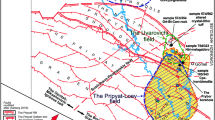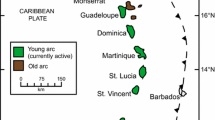Abstract
The Lherz orogenic lherzolite massif (Eastern French Pyrenees) displays one of the best exposures of subcontinental lithospheric mantle containing veins of amphibole pyroxenites and hornblendites. A reappraisal of the petrogenesis of these rocks has been attempted from a comprehensive study of their mutual structural relationships, their petrography and their mineral compositions. Amphibole pyroxenites comprise clinopyroxene, orthopyroxene and spinel as early cumulus phases, with garnet and late-magmatic K2O-poor pargasite replacing clinopyroxene, and subsolidus exsolution products (olivine, spinel II, garnet II, plagioclase). The original magmatic mineralogy and rock compositions were partly obscured by late-intrusive hornblendites and over a few centimetres by vein–wallrock exchange reactions which continued down to subsolidus temperatures for Mg–Fe. Thermobarometric data and liquidus parageneses indicate that amphibole pyroxenites started to crystallize at P ≥ 13 kbar and recrystallized at P < 12 kbar. The high AlVI/AlIV ratio (>1) of clinopyroxenes, the early precipitation of orthopyroxene and the late-magmatic amphibole are arguments for parental melts richer in silica but poorer in water than alkali basalts. Their modelled major element compositions are similar to transitional alkali basalt with about 1–3 wt% H2O. In contrast to amphibole pyroxenites, hornblendites only show kaersutite as liquidus phase, and phlogopite as intercumulus phase. They are interpreted as crystalline segregates from primary basanitic magmas (mg=0.6; 4–6 wt% H2O). These latter cannot be related to the parental liquids of amphibole pyroxenites by a fractional crystallization process. Rather, basanitic liquids mostly reused pre-existing pyroxenite vein conduits at a higher structural level (P ≤ 10 kbar). A continuous process of redox melting and/or alkali melt/peridotite interaction in a veined lithospheric mantle is proposed to account for the origin of the Lherz hydrous veins. The transitional basalt composition is interpreted in terms of extensive dissolution of olivine and orthopyroxene from wallrock peridotite by alkaline melts produced at the mechanical boundary layer/thermal boundary layer transition (about 45–50 km deep). Continuous fluid ingress allowed remelting of the deeper veined mantle to produce the basanitic, strongly volatiles enriched, melts that precipitated hornblendites. A similar model could be valid for the few orthopyroxene-rich hydrous pyroxenites described in basalt-hosted mantle xenoliths.
Similar content being viewed by others
Author information
Authors and Affiliations
Additional information
Received: 15 September 1999 / Accepted: 31 January 2000
Rights and permissions
About this article
Cite this article
Fabriès, J., Lorand, JP. & Guiraud, M. Petrogenesis of the amphibole-rich veins from the Lherz orogenic lherzolite massif (Eastern Pyrenees, France): a case study for the origin of orthopyroxene-bearing amphibole pyroxenites in the lithospheric mantle. Contrib Mineral Petrol 140, 383–403 (2001). https://doi.org/10.1007/s004100000132
Published:
Issue Date:
DOI: https://doi.org/10.1007/s004100000132




